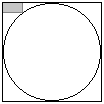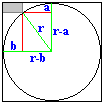Brain Teasers
1. The 8" pizza sells for $ 5.99 at my favorite pizza store. The store claims they have a great deal on the large 12" pizza, which is specially priced at $ 10.8. What is the per cent discount the store is offering?
Solution: The small pizza has a diameter of 8" and therefore an area proportional to 82. The large pizza has a diameter of 12" and therefore an area proportional to 122. If the pizzas are priced in accordance with their areas, then Price of large pizza / Price of small pizza = (12 / 8)2 = 2.25 or Price of large pizza = 2.25 x 5.99 = 13.5. Thus, Discount on large pizza = [1 - (10.8 / 13.5)] x 100 = 20 %.
2. Divide $517 (in whole $ increments) into a number of bags so that I can ask for any amount between $1 and $517, and you can give me the proper amount by giving me a certain number of these bags without opening them. What is the minimum number of bags you will require?
Solution: 10 bags. Here is the explanation. You divide $517 (in whole $ increments) into 10 bags as follows: 1, 2, 4, 8, 16, ... , 256, 6. The first 9 bags contain a total of $511 as per the following series: 2^0, 2^1, 2^2, 2^3, 2^4, ... , 2^8.
To gain a better understandstanding, consider the simple case where $12 needs to be divided into a number of bags. You divide $12 into 4 bags as follows: 1, 2, 4, 5. Then, If I ask for $: 1 2 3 4 5 6 7 8 9 10 11 12 You give $: 1 2 1+2 4 4+1 4+2 4+2+1 5+2+1 5+4 5+4+1 5+4+2 5+4+2+1
3. A number of children are standing in a circle. They are evenly spaced and the 4th child is directly opposite the 18th child. How many children are there altogether?
Solution: 28. The 4th child is directly opposite the 18th child. Since 18 - 4 = 14, there are 14 children in half the circle. (Note that half the circle includes one child out of the 4th child and the 18th child.) Thus, there are 28 children altogether in the full circle.
4.Each child in a family has at least 4 brothers and 3 sisters. What is the smallest number of children the family might have?
Solution: If each boy in the family has at least 4 brothers, then the smallest number of boys is 5. Similarly, if each girl in the family has at least 3 sisters, then the smallest number of girls is 4. Thus, the smallest number of children the family might have is 9.

5. In the above figure, the rectangle at the corner measures 1 cm x 2 cm. What is the radius of the circle in cm?
Solution: Using Pythagoras Theorem for the right-angled triangle in the figure alongside, (r - a)^2 + (r - b)^2 = r^2

Now, a = 1 cm and b = 2 cm. So, (r - 1)^2 + (r - 2)^2 = r^2 or r^2 - 2(1)r + 12 + r^2 - 2(2)r + 22 = r^2.
This simplifies to r^2 - 6r + 5 = 0. On factorizing, we get (r - 5)(r - 1) = 0. Thus, the radius of the circle is 5 cm.
You have an amazing collection of brain teasers.
I am by far no math wizard but after looking over question number three, I would have to disagree with the solution. I came up with 21 children in the circle if #18 and #4 were directly across from each other. 18 then add the three children standing in the circle before the forth.